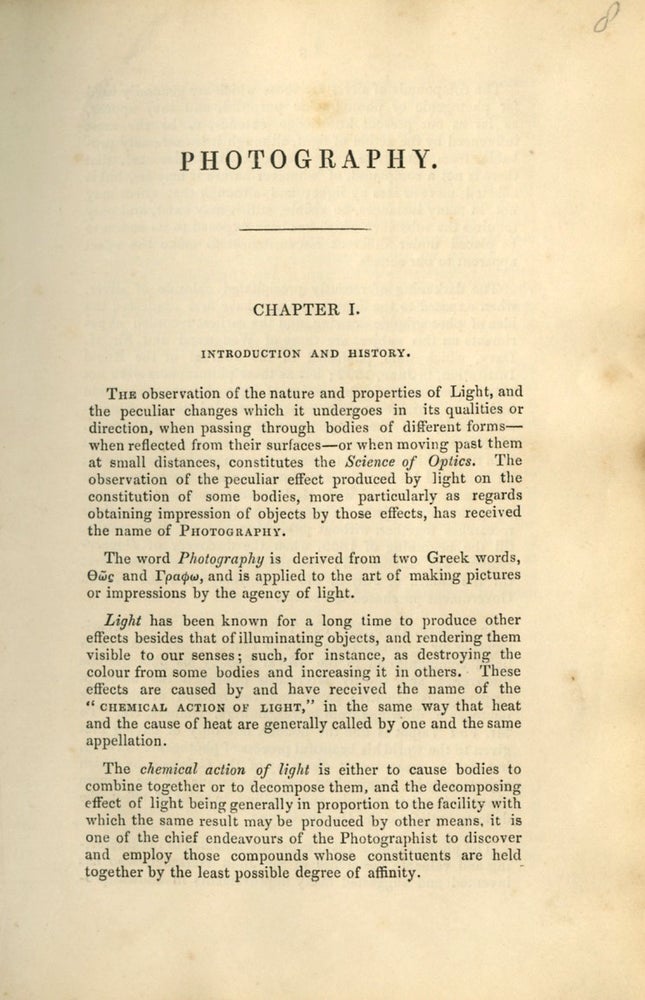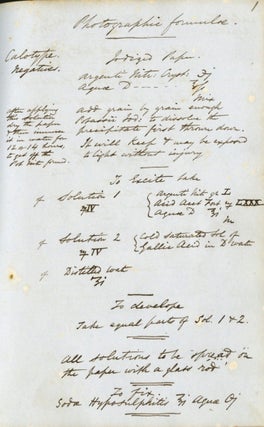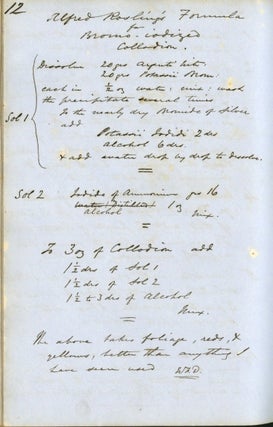A GUIDE TO PHOTOGRAPHY: CONTAINING SIMPLE AND PRACTICAL DETAILS OF THE LATEST AND MOST IMPROVED PROCESSES FOR THE PRODUCTION OF PICTURES BY THE CHEMICAL ACTION OF LIGHT: INCLUDING PHOTOGENIC DRAWING, CALOTYPE, DAGUERREOTYPE, CRYSOTYPE, CYANOTYPE, ANTHOTYPE, FERROTYPE, ENERGEATYPE, TITHONOTYPE AND THERMOGRAPHY.
London: Horne, Thornthwaite and Wood, 1845. Second edition, enlarged. 8vo., 5 - 62 pp., 3 engraved plates. Lacking preliminary leaves through the title page and the catalogue of photographic supplies, p. 63 - 72. Removed from a bound volume, this has added contemporary leaves of manuscript formulas by Dr. Hugh Welch Diamond. Very good. Housed in a paper over boards folder and slipcase with printed paper label. Item #52086
This is the second edition, enlarged, of one of the earliest British manuals which includes Talbot's calotype process, multiple other paper processes, as well as the latest advances in the daguerreian process. Although lacking the title page and the catalogue of photographic apparatus and supplies, this copy was owned by Dr. Hugh Welch Diamond and contains his marginal notes and corrections to the text as well as 14 pages of manuscript formulas and an index leaf.
Hugh Welch Diamond (1809 - 1886) entered the field of medicine first at the Royal College of Surgeons beginning in 1824. He opened a private practice in Soho Square in 1834, after he became a Fellow of the Royal College of Surgeons. In 1840, he switched his interest to psychiatry and adopted the practice of photography, which he utilized both professionally and as an avid amateur with landscapes, portraits and still life settings. He was appointed the superintendent of the Female Department of the Surrey County Lunatic Asylum in 1848 and continued in that capacity until 1858. His belief that photography was linked to empirical truth made it a valuable diagnostic tool; he was the first to use photography as such, earning the title of "father of clinical psychiatric photography." His portraits of the insane have been widely studied and reproduced.
Dr. Diamond frequently published articles on photography in NOTES AND QUERIES, was a founding member of the Photographic Society of London, serving as secretary 1859 - 1869, a member of the Photographic Exchange Club, and was the editor of the PHOTOGRAPHIC JOURNAL for ten years. In 1867, he served as a juror for photography at the Paris Exhibition. His friends and and colleagues included, Francis Bedford, P. H. Delamotte, Robert Howlett, John Dilwyn Llewelyn, Lady Caroline Nevill, H. P. Robinson, Robert Hunt, W.H.F. Talbot, F.S. Archer, and many others.
The circumstances of Diamond's interest in photography has yet to be reported; however, he was an ardent practitioner by the early 1840s. In 1840, Jabez Hogg entered the medical profession under Dr. Diamond and in 1843, he published his first photographic manual. In 1847, Frederick Scott Archer, was introduced to the calotype process of Talbot through his friend, Dr. Diamond, who was a frequent correspondent with Talbot. In 1851, F.S. Archer published his wet collodion process, which revolutionized the speed and sharpness of the photographic paper print associated with Talbot's process.
All the above lead to this unique copy of Thornthwaite's manual of 1847. Following the last page of the printed text, 18 leaves of a contemporary pale blue woven stock, and 1 leaf of white stock were stitched to the text block; of these, 14 pages contain manuscript formulas for: calotype negatives, Taylor's positive solution, Middleton's process (albumen), collodion process on glass, Read's solution for developing, Archer's collodion formula, Muller's process on paper, Talbot's instantaneous process, Alfred Rosling's formula for bromo-iodized collodion, and recovery of waste silver, etc. The remaining blue leaves are blank, followed by the manuscript index. Written towards the bottom of the twelfth page of manuscript formulas, "The above takes foliage, reds, & yellows, better than anything I have ever used. W.H.D." Preceding the first page of text are 2 blank leaves of the same pale blue paper. On the first printed page is the pencil number "8". What may be concluded is that this manual, and at least 7 other texts, were bound up for the personal use of Dr. Diamond, with the addition of blank pale blue paper on which he could add his comments and additional formulas. Why the title page and catalogue of apparatus was not included at that time remains unclear.
WorldCat locates four copies of this second edition: Yale University, National Gallery of Art, Cambridge University, and the National Library of Scotland. Roosens and Salu No. 6364. Gernsheim Incunabula, No. 676.
Price: $8,500.00





